
Iranian carpet salesmen watching an announcement of the nuclear pact Iran reached with six nations and the European Union, an agreement negotiated by the United States. The deal will end international oil and financial sanctions in return for limits on Iran’s nuclear production and fuel stockpile over the next 15 years: photo by Arash Khamooshi for The New York Times 14 July 2015
Joseph Ceravolo: Complaint
Have no social complaints
have no god complaints
was born a beggar
was born a beggar
live a beggar.
I have no complaints.
I have no complaints to the moon,
none to the stars,
none to the astrology of the mind,
none to the liars of religious words
or to the doom prophets
on the edges of truth.
Have no complaints.
Not to the rich, not to the poor,
not to the powerful, not to
the weak. I only ask for a little grace,
a tear here and there
shed for the brotherhood of man and woman,
not for me.
I have no complaints.
..............................
Joseph Ceravolo (1934-1988): Complaint, 27 August 1986, from Collected Poems, 2012
..............................
Joseph Ceravolo (1934-1988): Complaint, 27 August 1986, from Collected Poems, 2012
Iranians take to Tehran streets to hail nuclear #IranDeal: image by Agence France-Presse @AFP, 14 July 2015

Iranian coal miners eat lunch at a mine near the
city of Zirab 212 kilometers (132 miles) northeast of the capital
Tehran, on a mountain in Mazandaran province. International
sanctions linked to the decade-long dispute over Iran’s nuclear program
have hindered the import of heavy machinery and modern technology in all
sectors, and coal mining is no exception. The decision to privatize the
industry 10 years ago has further squeezed miners, who work often in
dangerous conditions -- and make just $300 a month, little more than
minimum wage: photo by Ebrahim Noroozi/AP. 19 August 2014

An Iranian coal miner pushes a metal cart loaded with coal at a mine near the city of Zirab 212 kilometers (132 miles) northeast of the capital Tehran, on a mountain in Mazandaran province. The miners move up to 100 tons of coal a day: photo by Ebrahim Noroozi/AP. 18 August 2014

Iranian coal miners pose for a photograph at a mine
on a mountain in Mazandaran province, near the city of Zirab 212
kilometers (132 miles) northeast of the capital Tehran.
International sanctions linked to the decade-long dispute over Iran’s
nuclear program have hindered the import of heavy machinery and modern
technology in all sectors, and coal mining is no exception. The decision
to privatize the industry 10 years ago has further squeezed miners, who
work often in dangerous conditions -- and make just $300 a month: photo by Ebrahim Noroozi/AP, 18 August 2014

An Iranian coal miner works inside a mine near the city of Zirab 212 kilometers (132 miles) northeast of the capital Tehran, on a mountain in Mazandaran province. The miners tunnel deep into the mountains, working in dark, narrow passageways where the risk of toxic gases and cave-ins is never far from their minds: photo by Ebrahim Noroozi/AP. 18 August 2014

An Iranian coal miner pushes an old metal cart to be
loaded with coal at a mine near the city of Zirab 212 kilometers (132
miles) northeast of the capital Tehran on a mountain in Mazandaran
province. A miner said they move up to 100 tons a day: photo by Ebrahim Noroozi/AP, 8 May 2014

An Iranian coal miner takes a break at a mine near
the city of Zirab 212 kilometers (132 miles) northeast of the capital
Tehran, on a mountain in Mazandaran province. International
sanctions linked to the decade-long dispute over Iran’s nuclear program
have hindered the import of heavy machinery and modern technology in all
sectors, and coal mining is no exception. The decision to privatize the
industry 10 years ago has further squeezed miners, who work often in
dangerous conditions -- and make just $300 a month, little more than
minimum wage: photo by Ebrahim Noroozi/AP. 8 May 2014

Iranian coal miners rest during a break at a mine on a
mountain in Mazandaran province, near the city of Zirab, 212 kilometers
(132 miles) northeast of the capital Tehran. The miners put in
long hours in often dangerous conditions and make just $300 a month,
little more than minimum wage: photo by Ebrahim Noroozi/AP. 6 May 2014

Iranian coal miners pose for a photograph before
taking a shower after a long day of work at a mine on a mountain in
Mazandaran province, near the city of Zirab 212 kilometers (132 miles)
northeast of the capital Tehran. The miners put in long hours in
often dangerous conditions making just $300 a month, little more than
minimum wage: photo by Ebrahim Noroozi/AP. 7 May 20144

An Iranian coal miner takes a shower while others
prepare to go home after a long day of work at a mine on a mountain in
Mazandaran province, near the city of Zirab, 212 kilometers (132 miles)
northeast of the capital Tehran. Around 1,200 miners work across 10
mines in the Mazandaran province, in a mountainous, verdant area. More
than 12,000 tons of coal is extracted from the mines each month, almost
all of which is shipped south for use in Iran’s steel industry: photo by Ebrahim Noroozi/AP. 6 May 2014

Angela Merkel, the German chancellor, visiting Infineon Technologies in Dresden, part of a tour of the German microelectronics industry. Infineon employs about 2,000 people in its Dresden factory, where it makes semiconductors: photo by Arno Burgi/Reuters via New York Times, 14 July 2015
The
conventional view holds that girih (geometric star-and-polygon, or
strapwork) patterns in medieval Islamic architecture were conceived by
their designers as a network of zigzagging lines, where the lines were
drafted directly with a straightedge and a compass. We show that by 1200
C.E. a conceptual breakthrough occurred in which girih patterns were
reconceived as tessellations of a special set of equilateral polygons
("girih tiles") decorated with lines. These tiles enabled the creation
of increasingly complex periodic girih patterns, and by the 15th
century, the tessellation approach was combined with self-similar
transformations to construct nearly perfect quasi-crystalline Penrose
patterns, five centuries before their discovery in the West.
Decagonal and Quasi-Crystalline Tilings in Medieval Islamic Architecture, by Peter J. Lu and Paul J. Steinhardt: abstract of a paper in Science 23, February 2007, Vol. 315. no. 5815
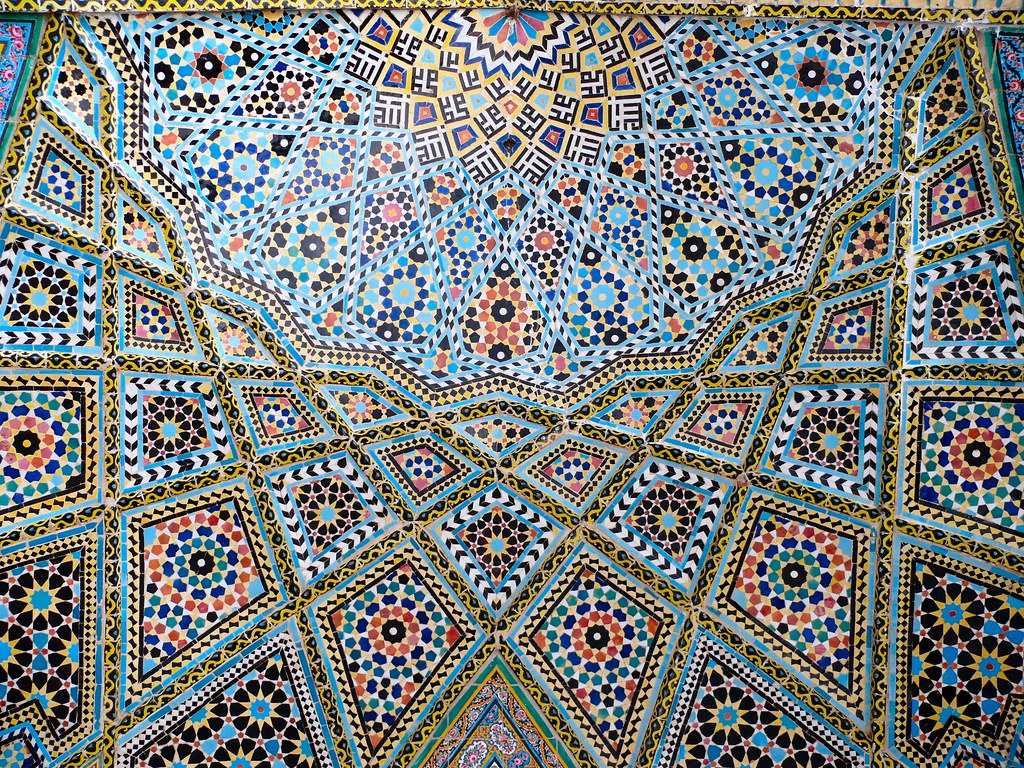
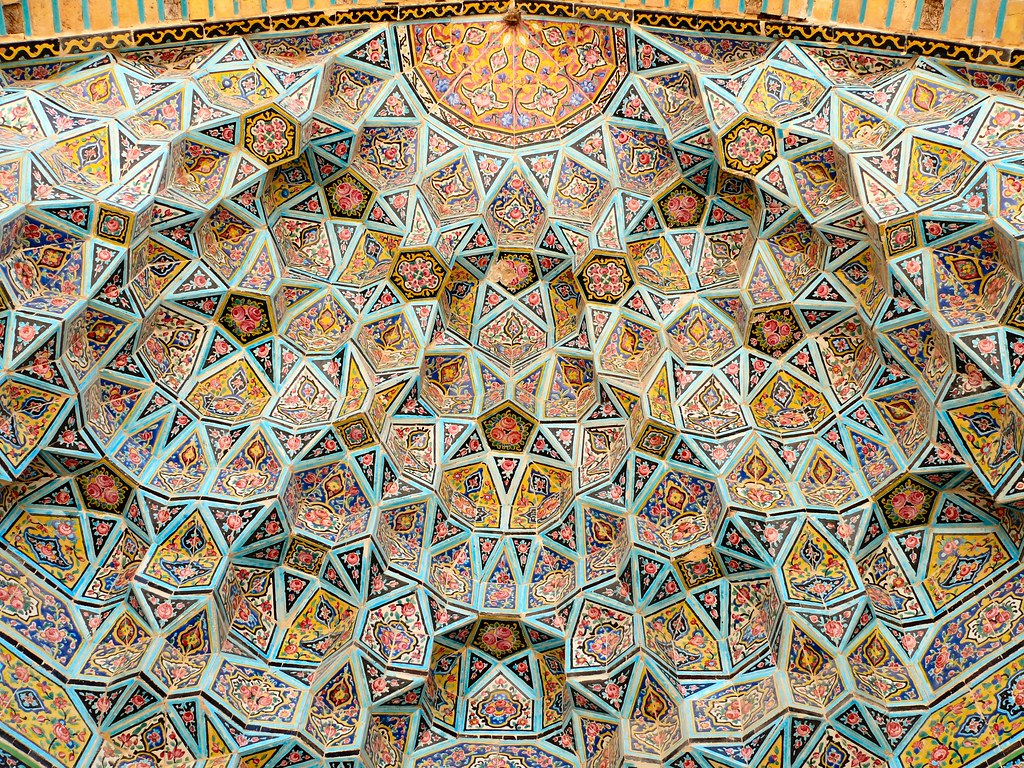
Decagonal and Quasi-Crystalline Tilings in Medieval Islamic Architecture, by Peter J. Lu and Paul J. Steinhardt: abstract of a paper in Science 23, February 2007, Vol. 315. no. 5815

A glance at heaven: vault at the Nasr ol Molk mosque, Shiraz: photo by dynamomosquito, 2008

Another glance at heaven: vault at the Nasr ol Molk mosque, Shiraz: photo by dyanamomosquito, 2007
For
all their tantalizing glimpses into medieval scientific knowledge, the
designs of the Darb-i Imam [in Isfahan, taken by Peter Lu as a template
for his thesis] and other Islamic buildings must also be
understood in their religious context. Geometric patterns in Islamic
architecture and ornamentation were used as much for spiritual as for
artistic reasons. As Robert Irwin writes in his study of Islamic art,
such patterns may have been viewed 'as exteriorized representations of
abstract, even mystical, thought' -- aiming to inspire contemplation or
to
make a statement about the imponderable harmonies of a divinely ordered
universe. Sufism in particular is closely linked to the practice of
geometry, above all in the form of symmetries, as a way of giving
physical expression to mystical thought.
Sebastian R. Prange, on the Lu thesis, in Islamic Arts and Architecture, 20 May 2012
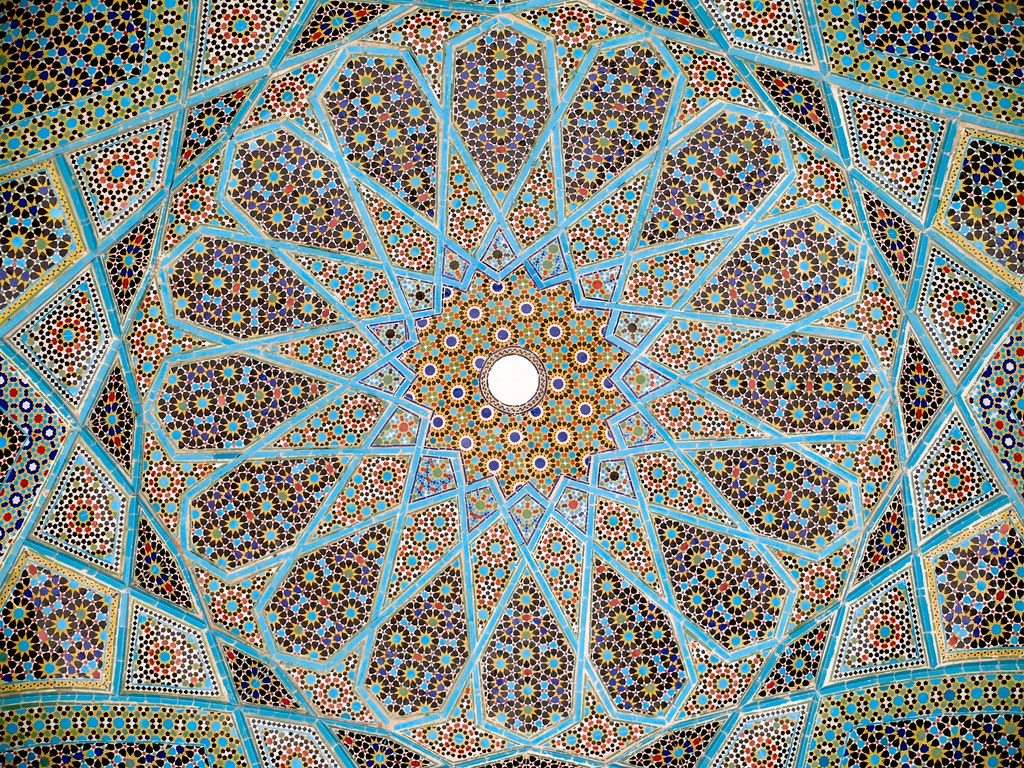
Eternity: ceramic tile mosaic, roof of the tomb of Persian poet Hafez, province of Fars, 2008: photo by dynamomosquito, 2008
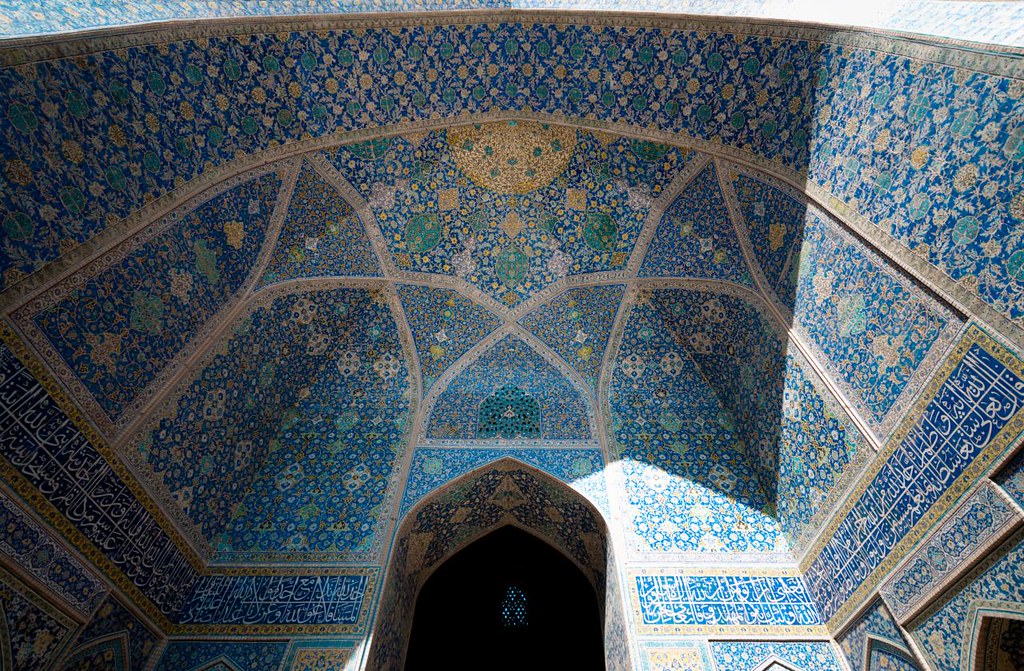
Imam (formerly Shah) Mosque (Masjed-e Imam), Isfahan: photo by Dara Mulhern, 18 October 2010
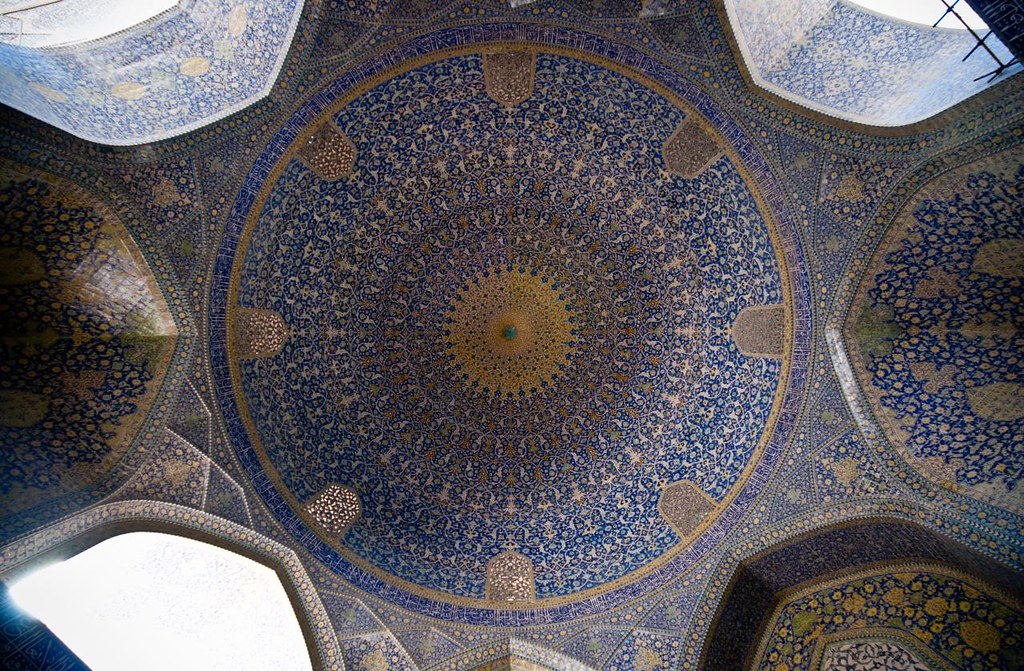
Main Dome, Imam (formerly Shah) Mosque (Masjed-e Imam), Isfahan (1611-1629}: photo by Dara Mulhern, 18 October 2010

Side Dome, Imam (formerly Shah) Mosque (Masjed-e Imam), Isfahan: photo by Dara Mulhern, 18 October 2010
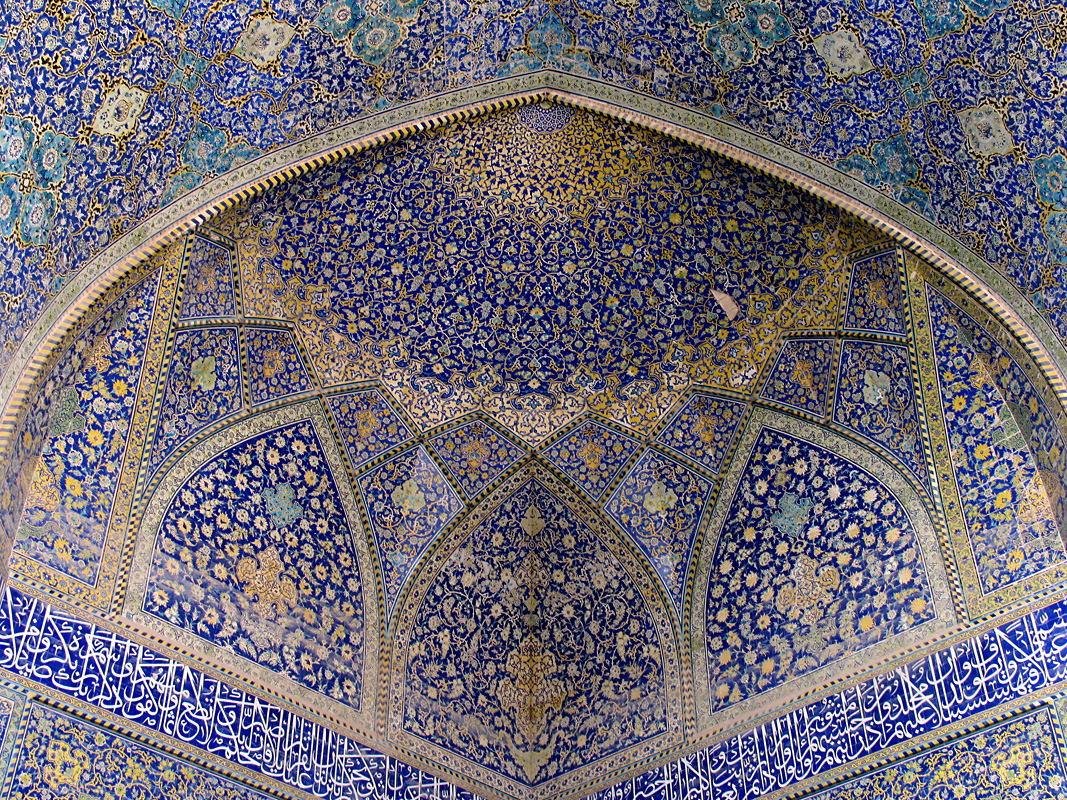
Imam (formerly Shah) Mosque, Isfahan: photo by HORIZON, 18 May 2006
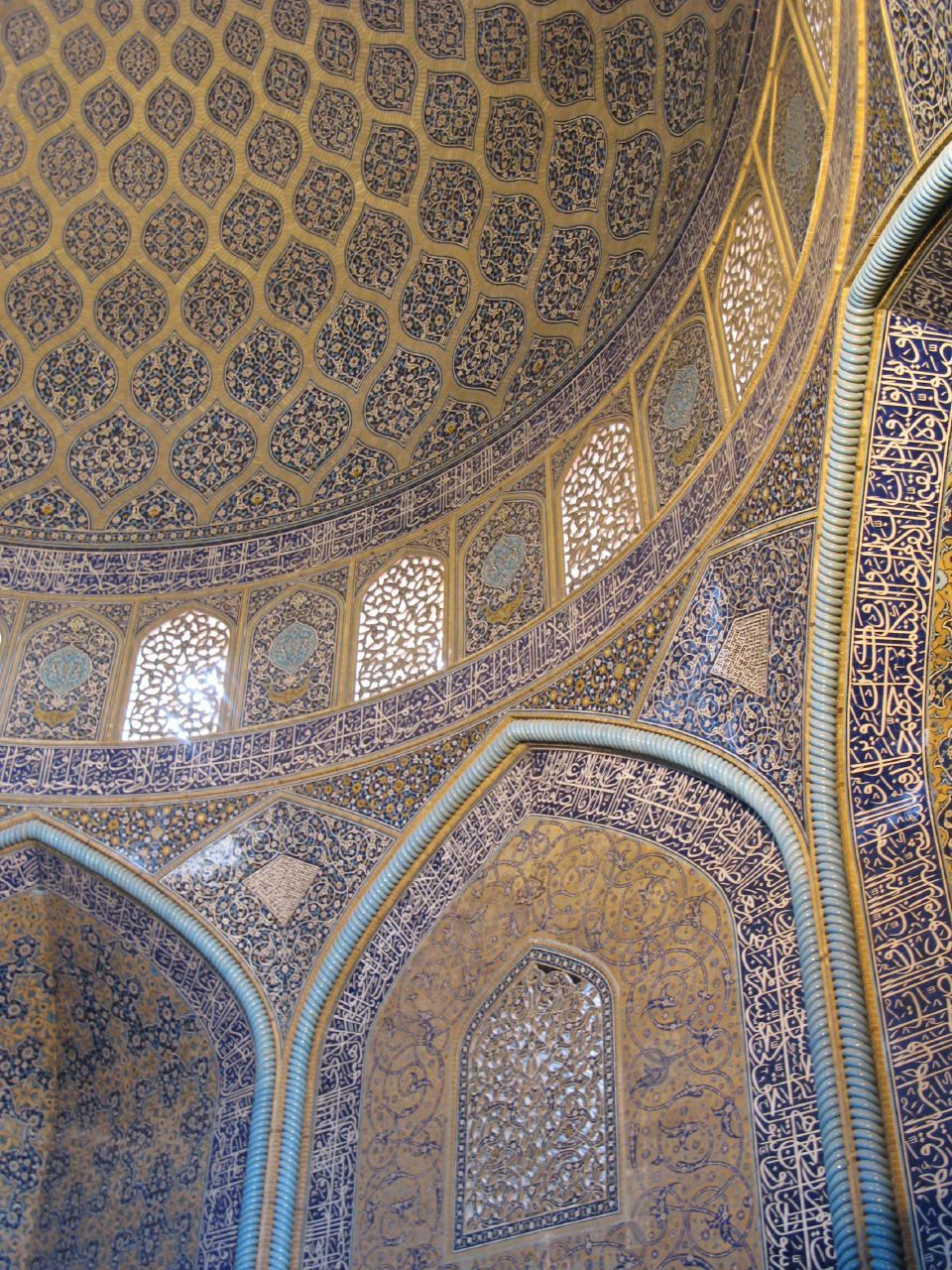
Sheikh Lotf Allah Mosque, Isfahan: photo by oceanbaby, 4 May 2007
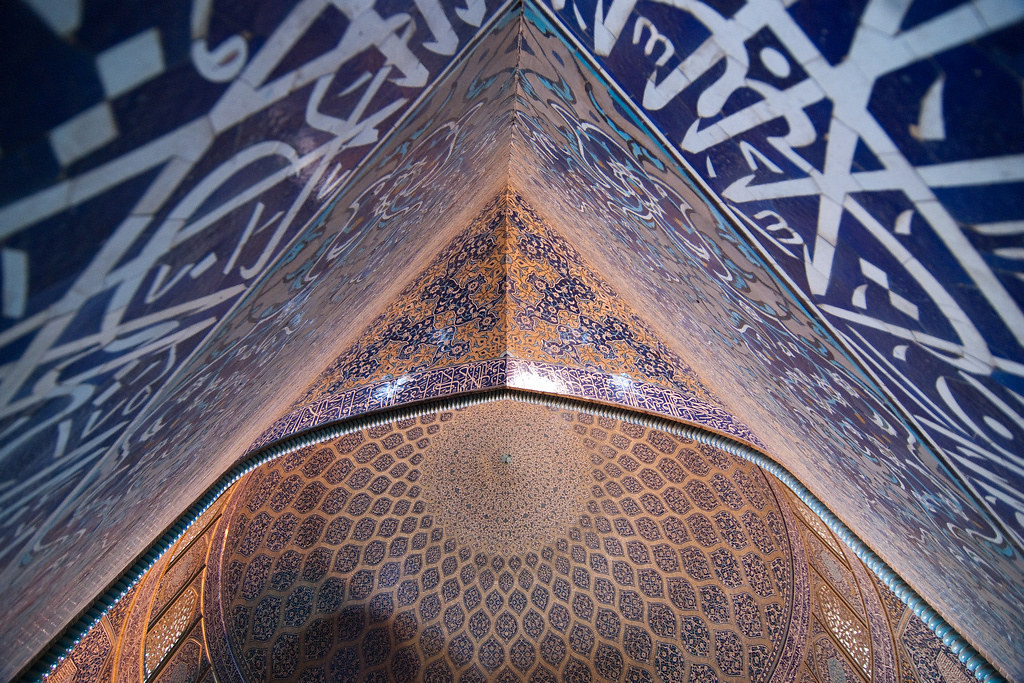
Sheikh Lotf Allah Mosque, Isfahan: photo by Behrooz Bashokooh, 15 March 2011
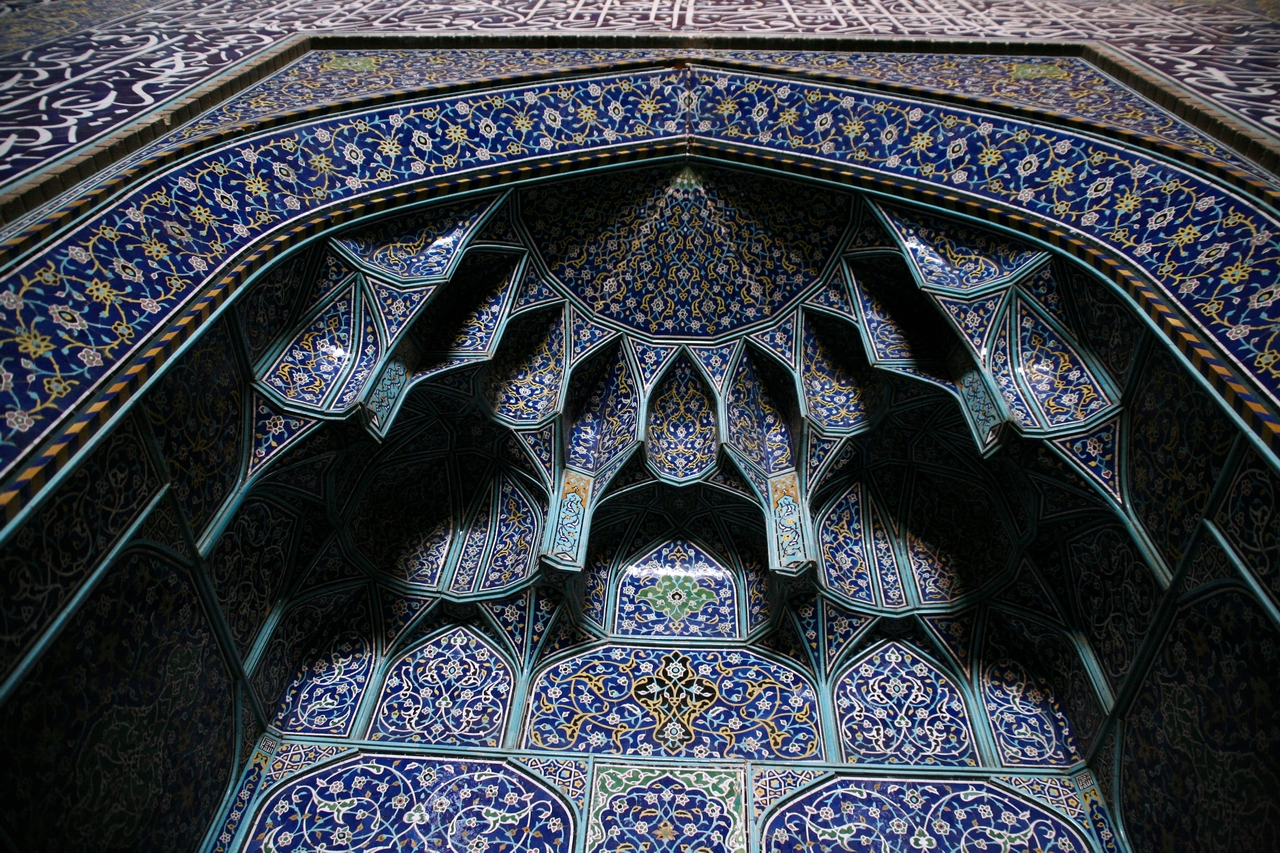
Muqarnas, Sheikh Lotf Allah Mosque, Isfahan: photo by Mandana Fard (baraneh), 8 January 2008

Iranian carpet salesmen watching an announcement of the nuclear pact Iran reached with six nations and the European Union, an agreement negotiated by the United States. The deal will end international oil and financial sanctions in return for limits on Iran’s nuclear production and fuel stockpile over the next 15 years: photo by Arash Khamooshi for The New York Times 14 July 2015
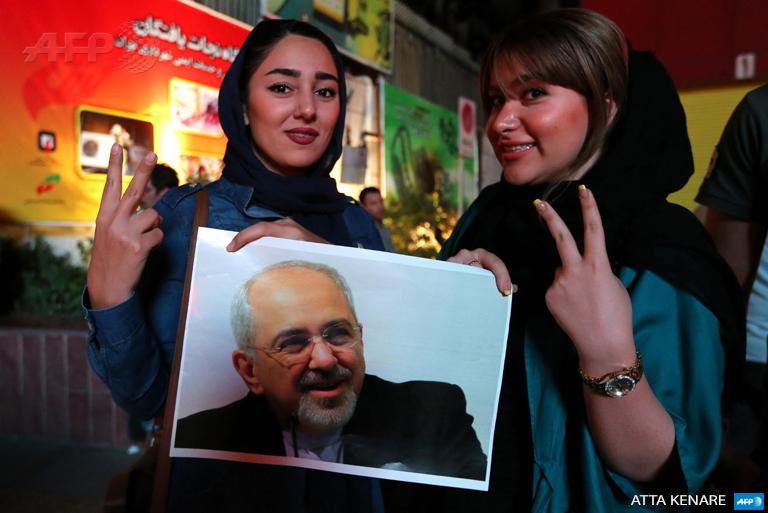

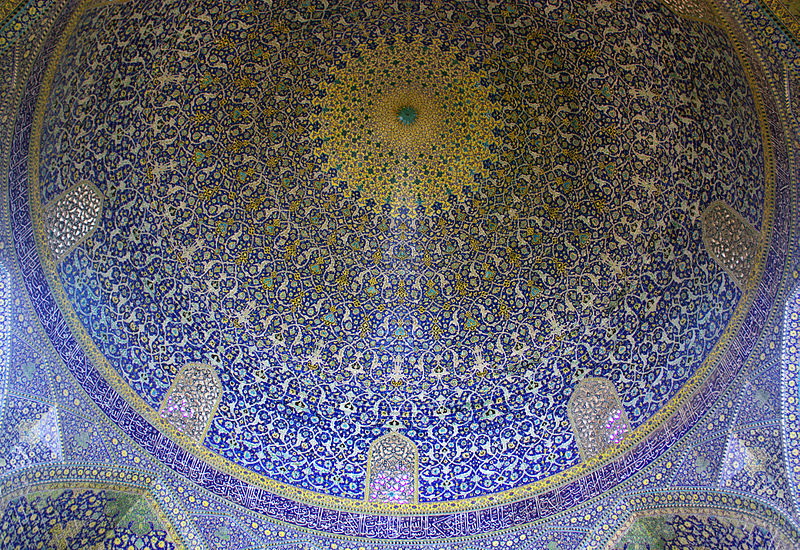
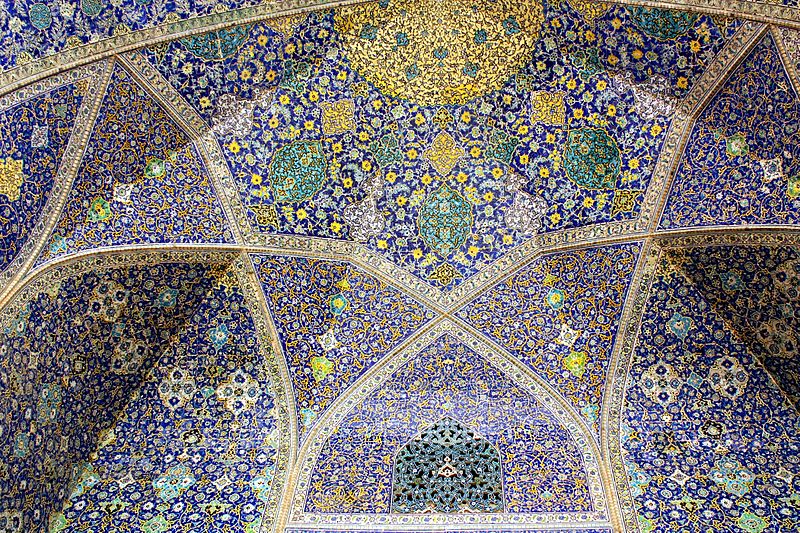


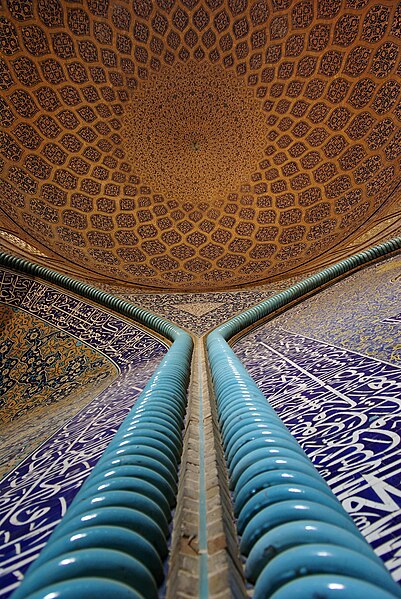

once again you pull together images and words to make connections beyond not just the headlines but the supposed analyses as well...what can I say Tom?...your output is ferociously enlightening and prolific...too late to stop now...(at least that's my wish...)
ReplyDeleteThanks very much, Michael -- and about stopping... my sentiments exactly.
ReplyDeleteRemembering Joe... the sheer heartfulness, a one-off, standing out the more clearly apart, as the years pass.
"...a tear here and there shed for the brotherhood of man and woman, not for me."
Tom,
ReplyDeleteYes, "I only ask for a little grace,
a tear here and there
shed for the brotherhood of man and woman,
not for me."
. . . those brutal coal miner photos, and then those glimpses of blue heaven . . .
Steve
The Israelis, Saudis and Republicans didn't like the deal. That means it has to be a good thing!
ReplyDeleteYes, yes. And to think that now that Iran will perhaps be permitted to update some of its Early Industrial Epoch machinery, acquire maybe a couple of new shovels, possibly a slightly less rusty wheelbarrow... who knows, let's not get ahead of ourselves here before the pinhead sages of the GOP have fired their totally predictable ignorance-laden salvos, but maybe even, Insh'Allah, a screwdriver for use in benign international humanitarian assistance projects -- frexample helping Bibi untangle his perpetually twisted knickers, bless his dark unhappy forever existentially threatened little heart.
ReplyDeleteSo then, now it comes out: there are actually humans in Iran. And guess what, they're happy!
Dove of peace at the window of the bunker, bearing an olive branch
Republicans hate the Iran nuclear deal because it means we won't bomb Iran: Trevor Timm, The Guardian, 14 July 2015
ReplyDeleteJeb Bush denounces Iran nuclear deal as appeasement: Ben Jacobs in Washington for The Guardian, 14 July 2015
Tom,
ReplyDeletehere's a song for you:
https://www.youtube.com/watch?v=lWyteHk0uho
Salams,
b.
Billoo, thanks, very beautiful, though beyond understanding that there are love and sweethearts involved, I'm afraid my Persian leaves a bit to be desired. Still a careful, completely mystified attention to the comment chain left me with the strong impression that this song has inflamed hearts, one way or the other...and where there is strong feeling, there is life.
ReplyDeleteAli Reza Efkethari: ey del agar aasheghi
... and concurrently I see that there isa bit of song and dance also going on in Tehran, and not the negotiating kind, for once.
Not for me
ReplyDeleteThose quiet and wholly good words of exception written with only those few words left. There's a lot of dreadful nonsense talked about the Spiritual. Whenever I read late Ceravolo I feel like I'm coming close to the heart of the matter.
The shifts in the post - from the miners to the Nasr Ol Molk Mosque: the truth, shining and soiled, the oarsmen and the Sirens' song.
The Hausfrau was a bit of a jolt though. I'll be a while washing the retinas in the sink.
Tom, I don't know Farsi either but a (Pakistani) friend roughly translated it for me as:
ReplyDeleteMy heart ! yearn for the Beloved , if you are a lover ...
Wait for the beloved at your door ,every day...
Open yourself, thine beloved is ready,
and be prepared with grace
No one knows when the beloved will appear...
But you ought to be ready for the union
with all that you have, everything at your disposal
please remain a friend with open eyes.
If you are attacked by the armies of sleep
You will fail...
if you want your life and love to remain alive
Be quiet and live with Attar and die with him...
Will ask a friend for a proper translation.
But I think it is in line with the poem you put up here insofar as if you are a lover, don't complain!
Duncan, Sorry about that, what with Mutti coming into the picture here and all... but you see we've kept her safely sealed in the airtight box. Her function is to demonstrate the brilliantly advanced industrial micro-technologies nobody but her special friends can share. If her radiance causes everything to turn a bilious yellow, well, maybe that just means it's how things were meant to be, in that wonderful, airtight, vacuum-sealed world.
ReplyDeleteBut do you suppose Mutti cares a fig about Penrose patterns, or where and how and by whom they were first understood and employed?
And if anybody is tempted to think the Iranians have enough centrifuges to produce a Penrose pattern, never fear; it'll be decades, at the least, before they'll be able to move into industrial production with it. So the Beebster's ranch should be safe from intelligent design, for a while longer at the least.
Billoo, my bumbling among the Farsi translation tools yielded pretty much the same gist, though I believe your friend has a more poetic way of putting things than any translation tool -- and that's perhaps as it should be.
I gather that Ali Reza Efkhetari has been something of an embattled figure -- "a scapegoat" as he puts it -- in his efforts to bring Iranian pop music into the present moment.
More power to him, and to poetry and song, in any case.
Such a terrific, moving poem. And the dance between coal and designs is powerful. Here's what I wrote about the Iran deal:
ReplyDeleteWhy are the House of Saud, the Israeli ultra-right (i.e., the regime in power) and the Republicans so freaked out over the Iran deal. It's not because of the threat of nuclear weapons - which has been contained - but because Iran is a large country with a young, educated population, with oil and other natural resources, with a vibrant culture despite its theocracy, a country capable of becoming prosperous and great, and this threatens unchallenged Zionist and Sunni hegemony in the region. The opponents cry out about Iranian support for terrorism, and they forget the years of support the US gave to Saddam Hussein to invade Iran at the cost of millions and the use of poison gas; they forget the US-British engineered coup to overthrow a democratically elected government; they forget US-Israeli support for the occupation of the southern Lebanon and how the Shia population resisted through its militia Hezbollah, and on. For the Saudi and Israeli governments Iran is more of a threat than ISIS (especially for the Saudis, since they've done a lot to foster such groups as ISIS). They would rather attack Assad than ISIS in Syria, for example. What they want is war, to destroy Iran and prevent the Shia Persian threat of a powerful counterbalance in the region. So, the outcry will go on. The world powers have managed to move in the direction of peace and not war, and nothing strikes fear into the hearts of Sunni theocrats, Zionist colonialists and Republican NeoCons than the idea of possible peace.
"... nothing strikes fear into the hearts of Sunni theocrats, Zionist colonialists and Republican NeoCons than the idea of possible peace."
ReplyDeleteAnd let's not forget the arms manufacturers, the military and everybody else who's got a stake in WAR ALL THE TIME.
On the other hand -- Joe C. For the ages.
You can say that again, Tom: Joe C.--He be the Man.
ReplyDelete